Geochemical Characteristics of the Volcanic Rocks Associated with Boron-Rich Deposits from the Xiongba Basin, Qinghai–Tibet Plateau
Abstract
:1. Introduction
2. Geological Setting
3. Materials and Methods
4. Results
4.1. Petrological Results
4.2. Major Elements
4.3. Trace and Rare Earth Elements
4.4. Characteristics of B Content in Volcanic Rocks
5. Discussions
5.1. Genesis of Miocene Volcanic Rocks in Xiongba Basin
5.2. Formation Mechanisms and Sources of Boron Enrichment in Volcanic Rocks
5.3. Implication for the Origin of Lacustrine B-Rich Sediments in QTP
6. Conclusions
Author Contributions
Funding
Data Availability Statement
Acknowledgments
Conflicts of Interest
References
- Stamatakis, M.G. A boron-bearing potassium feldspar in volcanic ash and tuffaceous rocks from Miocene lake deposits, Samos Island, Greece. Am. Mineral. 1989, 74, 230–235. [Google Scholar]
- García-Veigas, J.; Helvacı, C. Mineralogy and sedimentology of the Miocene Göcenoluk borate deposit, Kırka district, western Anatolia, Turkey. Sediment. Geol. 2013, 290, 85–96. [Google Scholar] [CrossRef]
- Borojević Šoštarić, S.; Brenko, T. The Miocene Western Balkan lithium-boron metallogenic zone. Miner. Depos. 2022, 58, 639–658. [Google Scholar] [CrossRef]
- Dill, H.G.; Kaufhold, S.; Helvacı, C. The physical–chemical regime of argillaceous interseam sediments in the Emet borate district, Turkey: A transition from non-metallic volcano-sedimentary to metallic epithermal deposits. J. Geochem. Explor. 2015, 156, 44–60. [Google Scholar] [CrossRef]
- Ortí, F.; Rosell, L.; García-Veigas, J.; Helvaci, C. Sulfate–Borate Association (Glauberite–Probertite) In the Emet Basin: Implications For Evaporite Sedimentology (Middle Miocene, Turkey). J. Sediment. Res. 2016, 86, 448–475. [Google Scholar] [CrossRef]
- Song, L.R.; Yu, C.Q.; Li, G.H.; Feng, Y.Y.; He, J.J. Characteristics of gravity anomalies and prediction of volcanosedimentary boron deposit distribution in the Xiongba area, Tibet. Appl. Geophys. 2015, 12, 516–522. [Google Scholar] [CrossRef]
- Floyd, P.; Helvaci, C.; Mittwede, S. Geochemical discrimination of volcanic rocks associated with borate deposits: An exploration tool? J. Geochem. Explor. 1998, 60, 185–205. [Google Scholar] [CrossRef]
- Xia, L.; Li, X.; Ma, Z.; Xu, X.; Xia, Z. Cenozoic volcanism and tectonic evolution of the Tibetan plateau. Gondwana Res. 2011, 19, 850–866. [Google Scholar] [CrossRef]
- Wang, Y.; Zhang, X.; Jiang, C.; Wei, H.; Wan, J. Tectonic controls on the late Miocene–Holocene volcanic eruptions of the Tengchong volcanic field along the southeastern margin of the Tibetan plateau. J. Asian Earth Sci. 2007, 30, 375–389. [Google Scholar] [CrossRef]
- Che, D.; Zheng, M.; Zhao, Y.; Zhang, Z.; Ye, C.; Xing, E.; Zhang, X.; Li, M. High Degree of Differentiation and Enrichment of Li, Rb and Cs in Potassic-Ultrapotassic Volcanic Rocks: An Example from the Lhasa Block, Tibet. Minerals 2023, 13, 342. [Google Scholar] [CrossRef]
- Su, W.; Cai, K.; He, Z.; Zhao, X.; Zhong, H.; Glorie, S.; de Grave, J. Late Oligocene to Pleistocene Thermo-Tectonic Evolution of the Karakoram Fault Zone: New Insights from Basement and Detrital Apatite Fission Track Thermochronology. Available at SSRN 4402303 2023, 32. [Google Scholar] [CrossRef]
- Zheng, M.; Chen, W.; Qi, W. New Findings and Perspective Analysis of Prospecting for Volcanic Sedimentary Boron Deposits in the Tibetan Plateau. Acta Geosci. Sin. 2016, 37, 407–418, (In Chinese with English abstract). [Google Scholar]
- Chang, C.f.; Pan, Y.S.; Sun, Y.Y. The tectonic evolution of Qinghai-Tibet Plateau: A review. In Tectonic Evolution of the Tethyan Region; Springer: Dordrecht, The Netherlands, 1989; pp. 415–476. [Google Scholar]
- Yin, A.; Harrison, T.M. Geologic evolution of the Himalayan-Tibetan orogen. Annu. Rev. Earth Planet. Sci. 2000, 28, 211–280. [Google Scholar] [CrossRef]
- Zhu, D.C.; Zhao, Z.D.; Niu, Y.; Dilek, Y.; Hou, Z.Q.; Mo, X.X. The origin and pre-Cenozoic evolution of the Tibetan Plateau. Gondwana Res. 2013, 23, 1429–1454. [Google Scholar] [CrossRef]
- Liu, D.; Zhao, Z.; Zhu, D.; Wang, Q.; Sui, Q.; Liu, Y.; Hu, Z.; Mo, X. The petrogenesis of postcollisional potassic-ultrapotassic rocks in Xungba basin, western Lhasa terrane: Constraints from zircon U-Pb geochronology and geochemistry. Acta Petrol. Sin. 2011, 27, 2045–2059, (In Chinese with English abstract). [Google Scholar]
- Yang, X.; Zhu, B.; White, P.D. Provenance of aeolian sediment in the Taklamakan Desert of western China, inferred from REE and major-elemental data. Quat. Int. 2007, 175, 71–85. [Google Scholar] [CrossRef]
- Lin, Y.; Zheng, M.; Ye, C.; Power, I.M. Trace and rare earth element geochemistry of Holocene hydromagnesite from Dujiali Lake, central Qinghai–Tibetan Plateau, China. Carbonates Evaporites 2019, 34, 1265–1279. [Google Scholar] [CrossRef]
- Taylor, S.R.; McLennan, S.M. The Continental Crust: Its Composition and Evolution; Blackwell Scientific: Oxford, UK, 1985. [Google Scholar]
- Kamber, B.S.; Webb, G.E. The geochemistry of late Archaean microbial carbonate: Implications for ocean chemistry and continental erosion history. Geochim. Cosmochim. Acta 2001, 65, 2509–2525. [Google Scholar] [CrossRef]
- Irvine, T.N.; Baragar, W. A guide to the chemical classification of the common volcanic rocks. Can. J. Earth Sci. 1971, 8, 523–548. [Google Scholar] [CrossRef]
- BAS, M.L.; Maitre, R.L.; Streckeisen, A.; Zanettin, B.; IUGS Subcommission on the Systematics of Igneous Rocks. A chemical classification of volcanic rocks based on the total alkali-silica diagram. J. Petrol. 1986, 27, 745–750. [Google Scholar] [CrossRef]
- Rickwood, P.C. Boundary lines within petrologic diagrams which use oxides of major and minor elements. Lithos 1989, 22, 247–263. [Google Scholar] [CrossRef]
- Prelević, D.; Akal, C.; Foley, S.; Romer, R.; Stracke, A.; Van Den Bogaard, P. Ultrapotassic mafic rocks as geochemical proxies for post-collisional dynamics of orogenic lithospheric mantle: The case of southwestern Anatolia, Turkey. J. Petrol. 2012, 53, 1019–1055. [Google Scholar] [CrossRef]
- Conticelli, S. The effect of crustal contamination on ultrapotassic magmas with lamproitic affinity: Mineralogical, geochemical and isotope data from the Torre Alfina lavas and xenoliths, Central Italy. Chem. Geol. 1998, 149, 51–81. [Google Scholar] [CrossRef]
- Boynton, W.V. Cosmochemistry of the rare earth elements: Meteorite studies. In Developments in Geochemistry; Elsevier: Amsterdam, The Netherlands, 1984; Volume 2, pp. 63–114. [Google Scholar]
- Sun, S.S.; McDonough, W.F. Chemical and isotopic systematics of oceanic basalts: Implications for mantle composition and processes. Geol. Soc. Lond. Spec. Publ. 1989, 42, 313–345. [Google Scholar] [CrossRef]
- Wang, Q.; Zhu, D.C.; Zhao, Z.D.; Liu, S.A.; Chung, S.L.; Li, S.M.; Liu, D.; Dai, J.G.; Wang, L.Q.; Mo, X.X. Origin of the ca. 90 Ma magnesia-rich volcanic rocks in SE Nyima, central Tibet: Products of lithospheric delamination beneath the Lhasa-Qiangtang collision zone. Lithos 2014, 198, 24–37. [Google Scholar] [CrossRef]
- Mo, X.; Zhao, Z.; Don, J.D.; Zhou, S.; Dong, G. Three types of collisional and post-collisional magmatism in the Lhasa block, Tibet and implications for India intra-continental subduction and mineralization: Evidence from Sr-Nd isotopes. Acta Petrol. Sin. 2006, 22, 795–803, (In Chinese with English abstract). [Google Scholar]
- Dalslåen, B.H.; Gasser, D.; Grenne, T.; Augland, L.E.; Corfu, F. Ordovician shoshonitic to ultrapotassic volcanism in the central Norwegian Caledonides: The result of sediment subduction, mantle metasomatism and mantle partial melting. Lithos 2020, 356, 105372. [Google Scholar] [CrossRef]
- Guo, Z.; Wilson, M.; Liu, J. Post-collisional adakites in south Tibet: Products of partial melting of subduction-modified lower crust. Lithos 2007, 96, 205–224. [Google Scholar] [CrossRef]
- Mallik, A.; Nelson, J.; Dasgupta, R. Partial melting of fertile peridotite fluxed by hydrous rhyolitic melt at 2–3 GPa: Implications for mantle wedge hybridization by sediment melt and generation of ultrapotassic magmas in convergent margins. Contrib. Mineral. Petrol. 2015, 169, 48. [Google Scholar] [CrossRef]
- Conticelli, S.; Avanzinelli, R.; Marchionni, S.; Tommasini, S.; Melluso, L. Sr-Nd-Pb isotopes from the Radicofani Volcano, Central Italy: Constraints on heterogeneities in a veined mantle responsible for the shift from ultrapotassic shoshonite to basaltic andesite magmas in a post-collisional setting. Mineral. Petrol. 2011, 103, 123–148. [Google Scholar] [CrossRef]
- Hofmann, A.W.; White, W.M. Mantle plumes from ancient oceanic crust. Earth Planet. Sci. Lett. 1982, 57, 421–436. [Google Scholar] [CrossRef]
- Pearce, J.A.; Peate, D.W. Tectonic implications of the composition of volcanic arc magmas. Annu. Rev. Earth Planet. Sci. 1995, 23, 251–285. [Google Scholar] [CrossRef]
- Sami, M.; Azer, M.; Abdel-Karim, A.A. Postcollisional Ferani Volcanics from North Arabian–Nubian Shield (South Sinai, Egypt): Petrogenesis and Implication for Ediacaran (607–593 Ma) Geodynamic Evolution. J. Geol. 2022, 130, 475–498. [Google Scholar] [CrossRef]
- Rudnick, R.L.; Fountain, D.M. Nature and composition of the continental crust: A lower crustal perspective. Rev. Geophys. 1995, 33, 267–309. [Google Scholar] [CrossRef]
- Zhao, Z.; Mo, X.; Luo, Z.; Zhou, S.; Dong, G.; Wang, L.; Zhang, F. Subduction of India beneath Tibet: Magmatism evidence. Earth Sci. Front. 2003, 10, 149–157, (in Chinese with English abstract). [Google Scholar]
- Mitchell, R.H.; Bergman, S.C. Petrology of Lamproites; Springer Science & Business Media: Berlin/Heidelberg, Germany, 1991. [Google Scholar]
- Castro, A.; Vogt, K.; Gerya, T. Generation of new continental crust by sublithospheric silicic-magma relamination in arcs: A test of Taylor’s andesite model. Gondwana Res. 2013, 23, 1554–1566. [Google Scholar] [CrossRef]
- Patiño Douce, A.E. Experimental generation of hybrid silicic melts by reaction of high-Al basalt with metamorphic rocks. J. Geophys. Res. Solid Earth 1995, 100, 15623–15639. [Google Scholar] [CrossRef]
- Hu, W.; Tian, S.; Yang, Z.; Zhang, Z. Petrogenesis of Miocene Chajiasi potassic rocks in western Lhasa block, Tibetan Plateau: Constraints from lithogeochemistry, geochronology and Sr-Nd isotopes. Miner. Depos. 2012, 31, 813–830, (In Chinese with English abstract). [Google Scholar]
- Garson, M.; Coats, J.; Rock, N.; Deans, T. Fenites, breccia dykes, albitites, and carbonatitic veins near the Great Glen Fault, Inverness, Scotland. J. Geol. Soc. 1984, 141, 711–732. [Google Scholar] [CrossRef]
- Guo, Z.; Wilson, M.; Liu, J.; Mao, Q. Post-collisional, potassic and ultrapotassic magmatism of the northern Tibetan Plateau: Constraints on characteristics of the mantle source, geodynamic setting and uplift mechanisms. J. Petrol. 2006, 47, 1177–1220. [Google Scholar] [CrossRef]
- Carminati, E.; Lustrino, M.; Doglioni, C. Geodynamic evolution of the central and western Mediterranean: Tectonics vs. igneous petrology constraints. Tectonophysics 2012, 579, 173–192. [Google Scholar] [CrossRef]
- Wang, Q.; Xu, J.; Zhao, Z. The summary and comment on research on a new kind of igneous rock-adakite. Adv. Earth Sci. 2001, 16, 201–208, (In Chinese with English abstract). [Google Scholar]
- Huang, W.L.; Wyllie, P. Phase relationships of S-type granite with H2O to 35 kbar: Muscovite granite from Harney Peak, South Dakota. J. Geophys. Res. Solid Earth 1981, 86, 10515–10529. [Google Scholar] [CrossRef]
- Cheng, Z.; Guo, Z. Post-collisional ultrapotassic rocks and mantle xenoliths in the Sailipu volcanic field of Lhasa terrane, south Tibet: Petrological and geochemical constraints on mantle source and geodynamic setting. Gondwana Res. 2017, 46, 17–42. [Google Scholar] [CrossRef]
- Bonin, B.; Azzouni-Sekkal, A.; Bussy, F.; Ferrag, S. Alkali-calcic and alkaline post-orogenic (PO) granite magmatism: Petrologic constraints and geodynamic settings. Lithos 1998, 45, 45–70. [Google Scholar] [CrossRef]
- Samuel, M.; Moussa, H.; Azer, M. A-type volcanics in central eastern Sinai, Egypt. J. Afr. Earth Sci. 2007, 47, 203–226. [Google Scholar] [CrossRef]
- Yücel, C.; Arslan, M.; Temizel, I.; Abdioğlu, E. Volcanic facies and mineral chemistry of Tertiary volcanics in the northern part of the Eastern Pontides, northeast Turkey: Implications for pre-eruptive crystallization conditions and magma chamber processes. Mineral. Petrol. 2014, 108, 439–467. [Google Scholar] [CrossRef]
- Zhao, J.H.; Zhou, M.F. Neoproterozoic adakitic plutons in the northern margin of the Yangtze Block, China: Partial melting of a thickened lower crust and implications for secular crustal evolution. Lithos 2008, 104, 231–248. [Google Scholar] [CrossRef]
- Vanderhaeghe, O.; Teyssier, C. Partial melting and flow of orogens. Tectonophysics 2001, 342, 451–472. [Google Scholar] [CrossRef]
- Leeman, W.; Hawkesworth, C. Open magma systems: Trace element and isotopic constraints. J. Geophys. Res. Solid Earth 1986, 91, 5901–5912. [Google Scholar] [CrossRef]
- McMillan, N.J.; Dickin, A.P.; Haag, D. Evolution of magma source regions in the Rio Grande rift, southern New Mexico. Geol. Soc. Am. Bull. 2000, 112, 1582–1593. [Google Scholar] [CrossRef]
- Leeman, W.P.; Carr, M.J.; Morris, J.D. Boron geochemistry of the Central American volcanic arc: Constraints on the genesis of subduction-related magmas. Geochim. Cosmochim. Acta 1994, 58, 149–168. [Google Scholar] [CrossRef]
- Marschall, H.R. Boron isotopes in the ocean floor realm and the mantle. Boron Isotopes: The Fifth Element; Springer: Berlin/Heidelberg, Germany, 2018; pp. 189–215. [Google Scholar]
- Palmer, M.R.; Swihart, G.H. Boron isotope geochemistry: An overview. In Boron; De Gruyter: Berlin, Germany, 2018; pp. 709–744. [Google Scholar]
- Tenthorey, E.; Hermann, J. Composition of fluids during serpentinite breakdown in subduction zones: Evidence for limited boron mobility. Geology 2004, 32, 865–868. [Google Scholar] [CrossRef]
- Leeman, W.P. Implications for Subduction Processes. Subduction Top Bottom 1996, 96, 269. [Google Scholar]
- Humphris, S.E. The mobility of the rare earth elements in the crust. In Developments in Geochemistry; Elsevier: Amsterdam, The Netherlands, 1984; Volume 2, pp. 317–342. [Google Scholar]
- Othman, D.B.; White, W.M.; Patchett, J. The geochemistry of marine sediments, island arc magma genesis, and crust-mantle recycling. Earth Planet. Sci. Lett. 1989, 94, 1–21. [Google Scholar] [CrossRef]
- Johnson, M.C.; Plank, T. Dehydration and melting experiments constrain the fate of subducted sediments. Geochem. Geophys. Geosyst. 2000, 1. [Google Scholar] [CrossRef]
- Kay, R. Elemental abundances relevant to identification of magma sources. Philos. Trans. R. Soc. Lond. Ser. A Math. Phys. Sci. 1984, 310, 535–547. [Google Scholar]
- Gméling, K.; Németh, K.; Martin, U.; Eby, N.; Varga, Z. Boron concentrations of volcanic fields in different geotectonic settings. J. Volcanol. Geotherm. Res. 2007, 159, 70–84. [Google Scholar] [CrossRef]
- Zhang, W.; Tan, H.; Xu, W.; Huang, J. Boron source and evolution of the Zabuye salt lake, Tibet: Indication from boron geochemistry and isotope. Appl. Geochem. 2023, 148, 105516. [Google Scholar] [CrossRef]
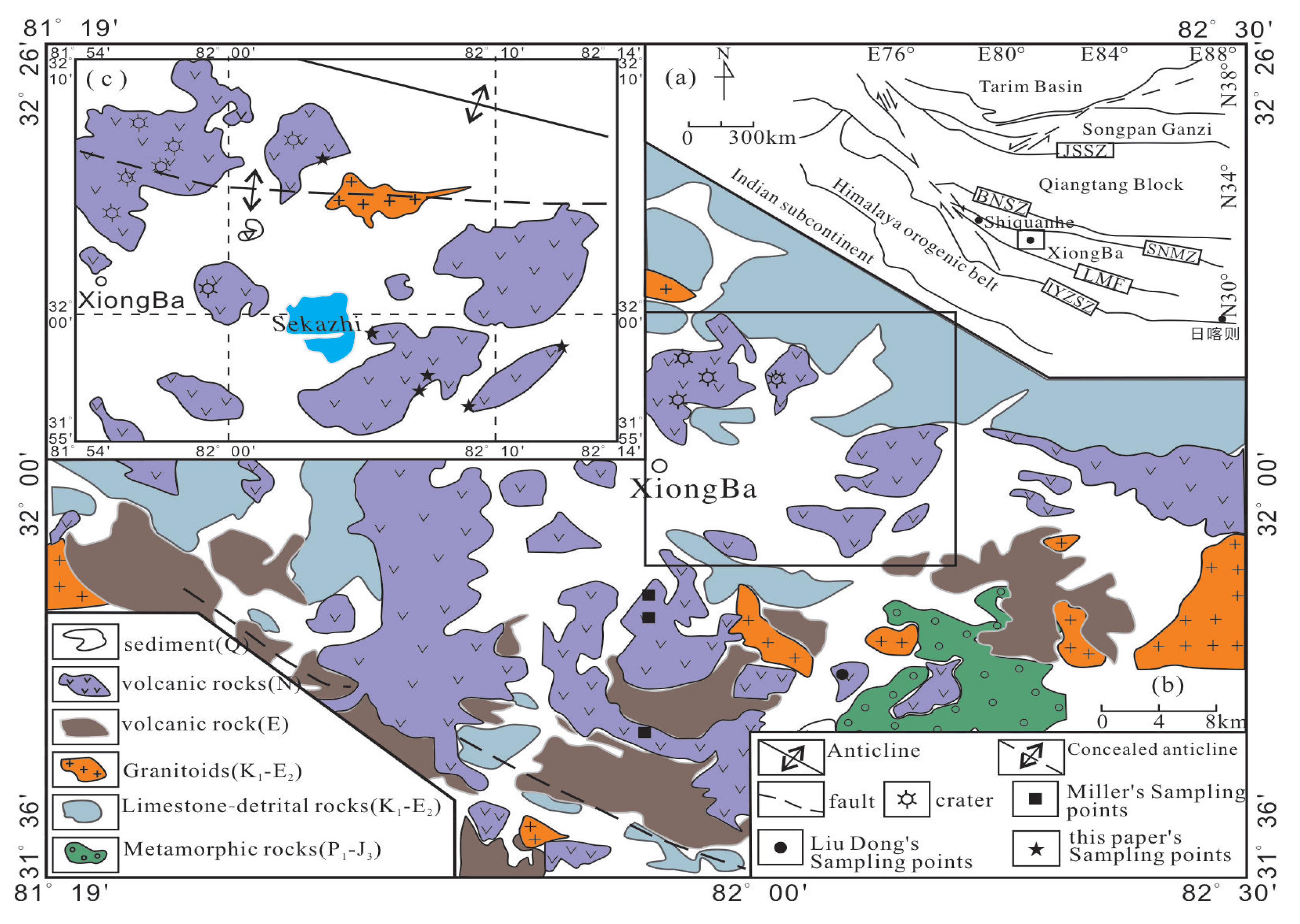
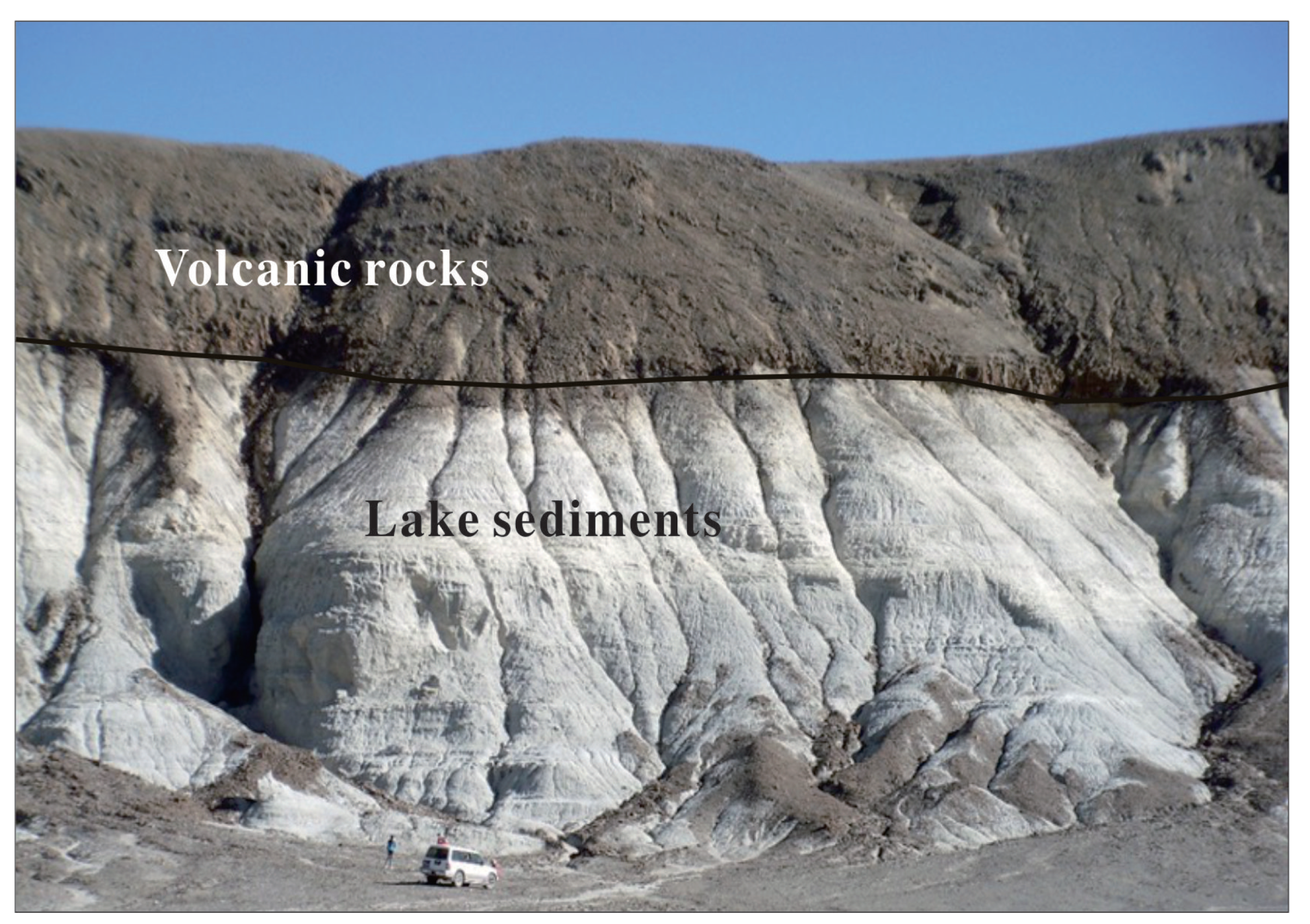

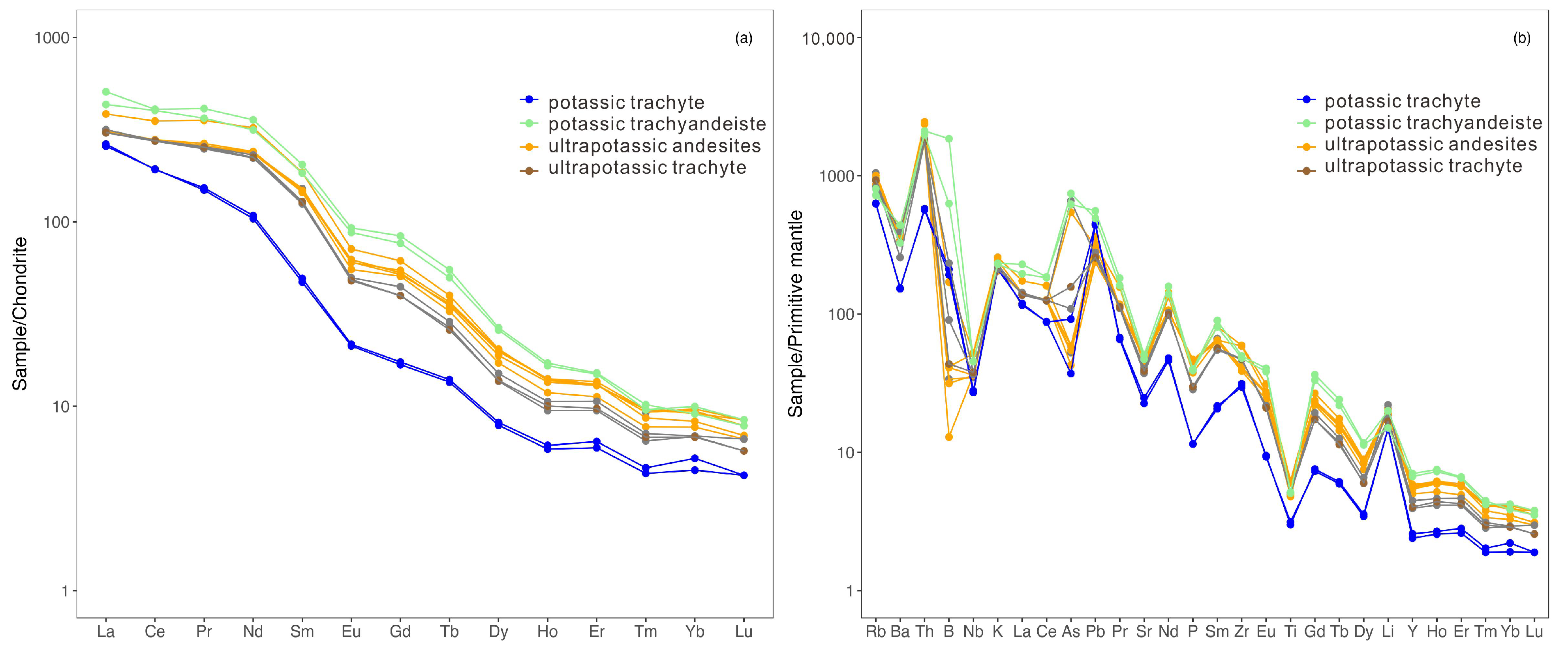
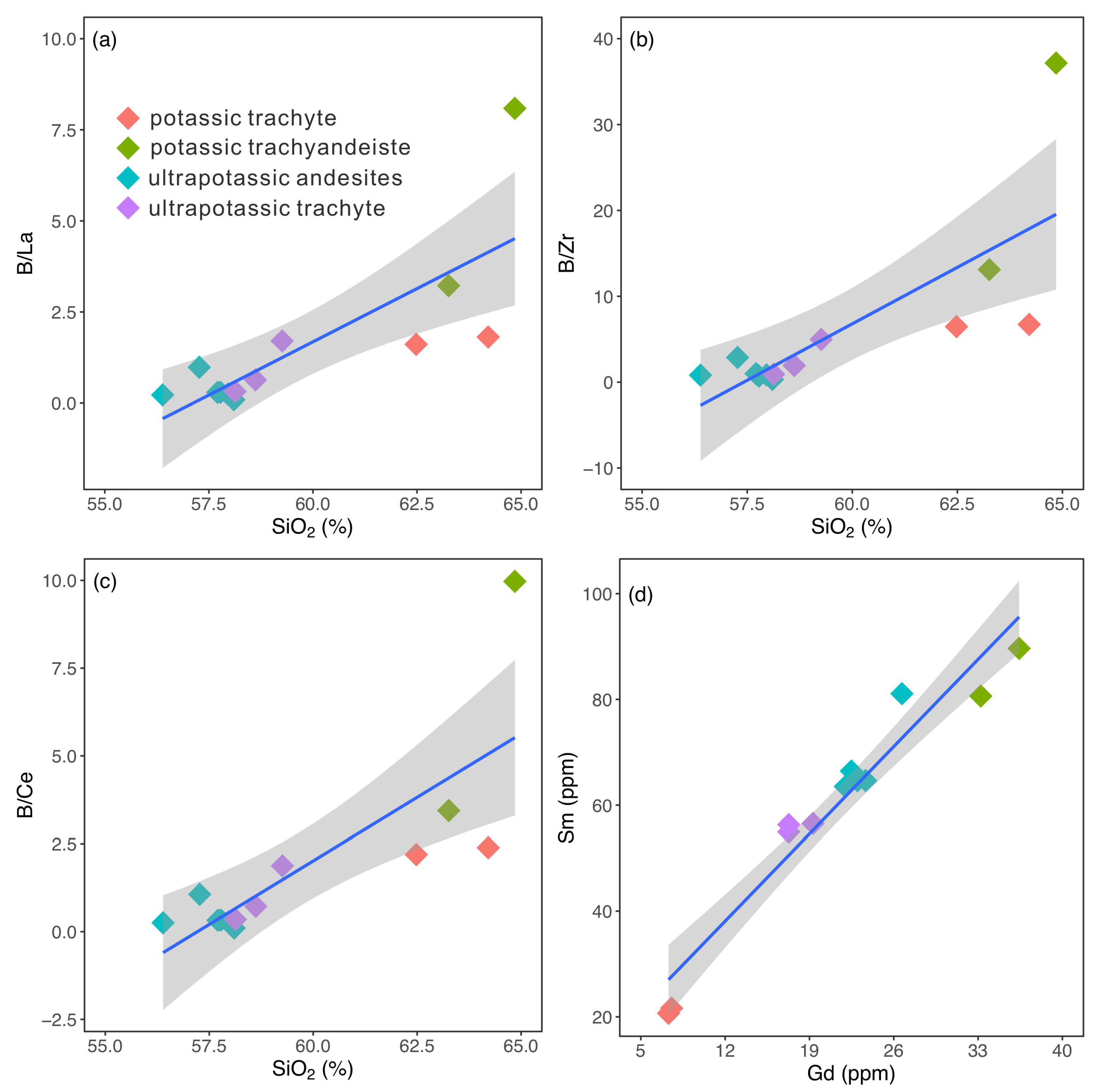

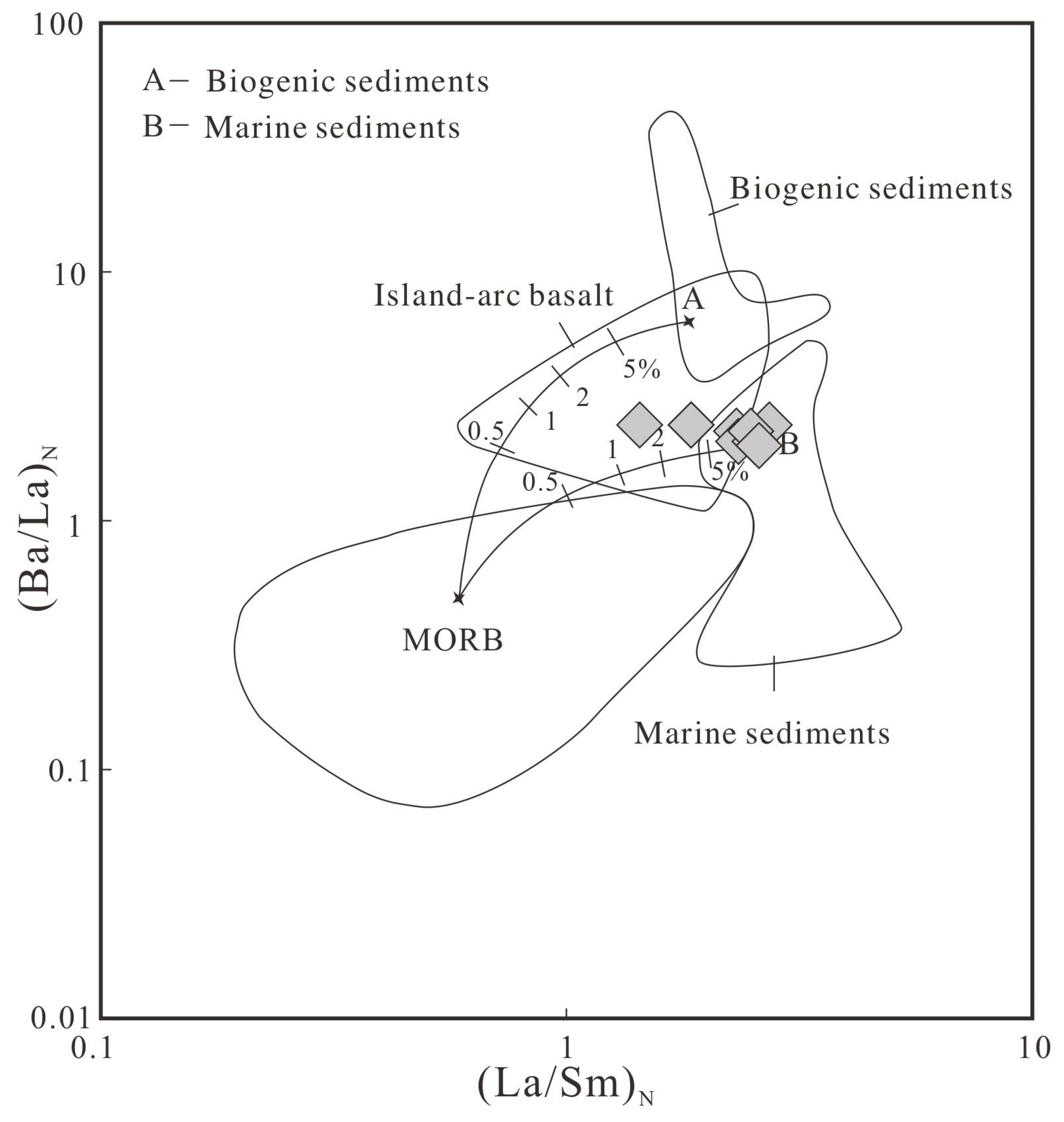
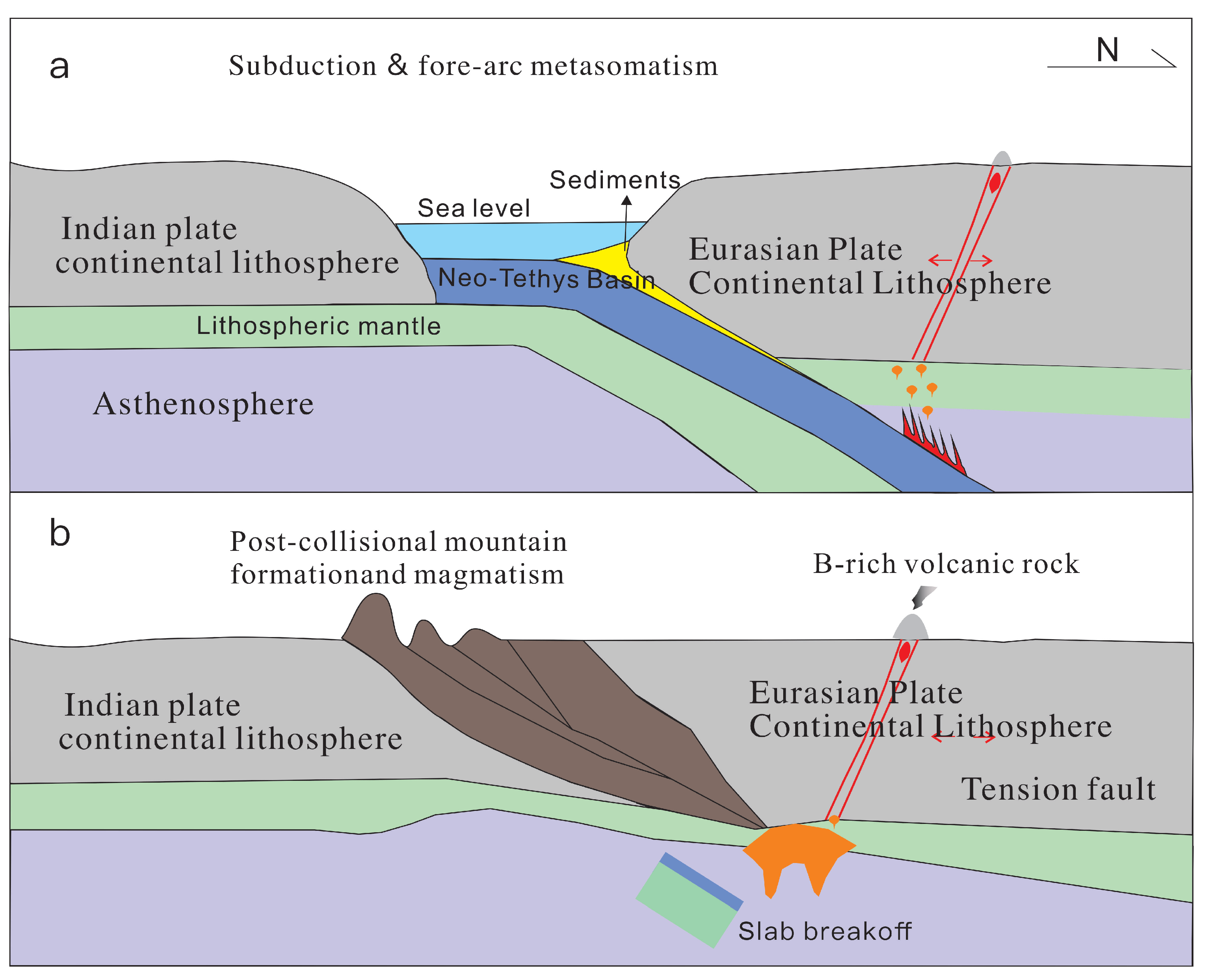
| Sample | D2B8 | D2B10 | D2B11 | D2B12 | D8B3 | D8B4 | D8B7 | D8B8 | D8B17 | D8B18 | D8B19 | SKP1-14 | SKP1-15 |
|---|---|---|---|---|---|---|---|---|---|---|---|---|---|
| SiO | 57.96 | 57.71 | 56.39 | 58.1 | 62.48 | 64.21 | 57.27 | 57.78 | 59.26 | 58.62 | 58.13 | 63.26 | 64.85 |
| TiO | 1.08 | 1.07 | 1.04 | 1.08 | 0.65 | 0.68 | 1.35 | 1.31 | 1.11 | 1.11 | 1.11 | 1.12 | 1.1 |
| AlO | 12.63 | 12.7 | 12.55 | 12.69 | 14.92 | 15.29 | 12.48 | 12.62 | 13.04 | 13.85 | 12.87 | 11.77 | 11.79 |
| FeO | 4.47 | 4.95 | 4.39 | 4.49 | 2.99 | 3.07 | 5.29 | 5.37 | 4.65 | 4.5 | 3.98 | 6.15 | 4.41 |
| MnO | 0.08 | 0.08 | 0.07 | 0.08 | 0.05 | 0.04 | 0.09 | 0.08 | 0.08 | 0.06 | 0.06 | 0.12 | 0.04 |
| MgO | 6.39 | 6.19 | 5.74 | 6.26 | 1.65 | 1.5 | 5.64 | 6.09 | 4.91 | 4.16 | 4.84 | 2.35 | 2.48 |
| CaO | 5.22 | 4.8 | 5.49 | 5.08 | 4.36 | 2.95 | 4.13 | 4.07 | 4.5 | 4.92 | 5.49 | 2.02 | 1.66 |
| NaO | 2.54 | 2.53 | 1.37 | 2.55 | 2.18 | 2.15 | 1.97 | 1.9 | 1.83 | 2.18 | 1.63 | 1.73 | 2.13 |
| KO | 6.35 | 6.44 | 6.16 | 6.41 | 6.33 | 6.66 | 7.73 | 7.33 | 6.85 | 6.35 | 6.78 | 6.88 | 6.70 |
| PO | 0.99 | 0.97 | 0.98 | 1.02 | 0.25 | 0.25 | 0.87 | 0.82 | 0.65 | 0.62 | 0.65 | 0.85 | 0.87 |
| LOI | 0.94 | 0.9 | 4.31 | 0.81 | 3.12 | 1.99 | 1.92 | 0.89 | 2.08 | 2.29 | 3.45 | 2.38 | 1.86 |
| Sample | D2B8 | D2B10 | D2B11 | D2B12 | D8B3 | D8B4 | D8B7 | D8B8 | D8B17 | D8B18 | D8B19 | SKP1-14 | SKP1-15 |
|---|---|---|---|---|---|---|---|---|---|---|---|---|---|
| Li | 33 | 32.5 | 31.7 | 30.7 | 23.8 | 23.7 | 29.8 | 30.3 | 35.2 | 28.1 | 26.8 | 24 | 31.9 |
| Be | 12.9 | 13.6 | 10.4 | 11.5 | 12.9 | 13.6 | 14 | 12.4 | 10.1 | 9.25 | 10 | 11 | 11.5 |
| Sc | 14.6 | 15.4 | 13.7 | 15.7 | - | - | - | - | 12.5 | 12.7 | 12.8 | 13.7 | 11.1 |
| V | 105 | 109 | 106 | 99.8 | 57.4 | 58.8 | 87.2 | 103 | 101 | 98.8 | 97.1 | 101 | 103 |
| Cr | 385 | 401 | 374 | 381 | 45.8 | 47.7 | 424 | 428 | 279 | 260 | 283 | 437 | 469 |
| Co | 26.7 | 46.9 | 20.9 | 22.1 | 8.21 | 6.98 | 23.5 | 26.7 | 22.4 | 16.5 | 23.1 | 39.6 | 30.6 |
| Ni | 263 | 290 | 178 | 195 | 16.3 | 13.3 | 259 | 288 | 164 | 94.3 | 157 | 232 | 221 |
| Cu | 57.2 | 51.6 | 63.1 | 54.1 | 10.6 | 7.48 | 44.3 | 41.1 | 28 | 22.9 | 24.8 | 33.3 | 41.9 |
| Zn | 85.7 | 110 | 58.5 | 73.5 | 63.1 | 60 | 71.2 | 75.1 | 69.8 | 72.6 | 70.7 | 74.5 | 107 |
| Ga | 21.9 | 22.5 | 20.6 | 21.3 | 26.7 | 27.3 | 22.6 | 22.8 | 22 | 23.5 | 22 | 19.7 | 21.2 |
| Rb | 664 | 636 | 546 | 587 | 401 | 398 | 605 | 607 | 590 | 524 | 586 | 458 | 509 |
| Sr | 974 | 1035 | 1034 | 1071 | 522 | 476 | 880 | 822 | 787 | 854 | 819 | 994 | 1072 |
| Zr | 450 | 466 | 434 | 459 | 332 | 350 | 663 | 657 | 525 | 524 | 530 | 537 | 557 |
| Nb | 24.7 | 25.7 | 25.6 | 26 | 19.3 | 19.9 | 37.3 | 36.7 | 26.6 | 26.1 | 27 | 32.4 | 32.3 |
| Ba | 2551 | 2385 | 2578 | 2366 | 1073 | 1063 | 2734 | 2658 | 1791 | 2757 | 2299 | 3059 | 2283 |
| Hf | 12.6 | 12.6 | 11.8 | 13 | - | - | - | - | 15.2 | 14 | 14.5 | 14.8 | 14.8 |
| Ta | 1.45 | 1.45 | 1.46 | 1.59 | - | - | - | - | 1.46 | 1.48 | 1.55 | 1.77 | 1.69 |
| Pb | 47.6 | 48.7 | 56.9 | 43.8 | 82.7 | 81.4 | 59.2 | 66.9 | 48.7 | 51.5 | 47.3 | 90.9 | 103 |
| Th | 153 | 152 | 144 | 153 | 48.1 | 49 | 208 | 201 | 150 | 156 | 150 | 168 | 179 |
| U | 23.9 | 23.5 | 21.7 | 22.3 | - | - | - | - | 19.4 | 17.2 | 22.3 | 20.4 | 19.2 |
| As | 5.26 | 5.88 | 54.3 | 4.27 | 9.18 | 3.71 | 5.89 | 5.46 | 65.8 | 10.9 | 15.7 | 74.2 | 62.1 |
| Mn | 552 | 661 | 517 | 629 | 382 | 345 | 651 | 626 | 618 | 462 | 496 | 781 | 324 |
| B | 20.3 | 24.6 | 18.9 | 7.73 | 115 | 126 | 102 | 25 | 140 | 54.3 | 26.1 | 377 | 1109 |
| La | 95.6 | 96.6 | 97 | 97.2 | 81.7 | 79.6 | 119 | 97.2 | 94.1 | 97.8 | 94.5 | 134 | 157 |
| Ce | 223 | 225 | 222 | 223 | 155 | 156 | 284 | 223 | 221 | 223 | 222 | 324 | 329 |
| Pr | 31.6 | 32.4 | 31.7 | 31.3 | 18.6 | 18.1 | 43.2 | 31.3 | 30.3 | 31.1 | 30.9 | 44.4 | 50.1 |
| Nd | 142 | 144 | 141 | 141 | 64.8 | 62.4 | 194 | 141 | 133 | 138 | 134 | 189 | 214 |
| Sm | 29.5 | 28.7 | 28.2 | 28.7 | 9.6 | 9.18 | 36 | 28.7 | 24.4 | 25.1 | 25 | 35.8 | 39.8 |
| Eu | 4.44 | 4.42 | 4.05 | 4.58 | 1.59 | 1.56 | 5.23 | 4.58 | 3.57 | 3.65 | 3.52 | 6.43 | 6.8 |
| Gd | 13.4 | 14.1 | 13.1 | 13.7 | 4.5 | 4.35 | 15.9 | 13.7 | 10.3 | 11.5 | 10.3 | 19.8 | 21.7 |
| Tb | 1.7 | 1.74 | 1.55 | 1.66 | 0.66 | 0.64 | 1.89 | 1.66 | 1.27 | 1.36 | 1.23 | 2.36 | 2.6 |
| Dy | 6.37 | 6.51 | 5.53 | 6.07 | 2.63 | 2.54 | 6.57 | 6.07 | 4.4 | 4.84 | 4.44 | 8.34 | 8.58 |
| Ho | 1.01 | 1.01 | 0.85 | 0.97 | 0.44 | 0.42 | 0.99 | 0.97 | 0.68 | 0.76 | 0.72 | 1.19 | 1.23 |
| Er | 2.75 | 2.85 | 2.36 | 2.72 | 1.35 | 1.25 | 2.76 | 2.72 | 1.99 | 2.23 | 2.04 | 3.13 | 3.18 |
| Tm | 0.3 | 0.31 | 0.25 | 0.31 | 0.15 | 0.14 | 0.28 | 0.31 | 0.21 | 0.23 | 0.22 | 0.31 | 0.33 |
| Yb | 2.02 | 1.91 | 1.61 | 1.97 | 1.09 | 0.94 | 1.73 | 1.97 | 1.43 | 1.44 | 1.42 | 2.08 | 1.9 |
| Lu | 0.28 | 0.28 | 0.22 | 0.26 | 0.14 | 0.14 | 0.23 | 0.26 | 0.19 | 0.22 | 0.19 | 0.28 | 0.26 |
| Y | 25.9 | 26.6 | 22.8 | 24.7 | 11.7 | 10.9 | 25.4 | 26 | 17.9 | 20.3 | 18.3 | 30.4 | 31.9 |
Disclaimer/Publisher’s Note: The statements, opinions and data contained in all publications are solely those of the individual author(s) and contributor(s) and not of MDPI and/or the editor(s). MDPI and/or the editor(s) disclaim responsibility for any injury to people or property resulting from any ideas, methods, instructions or products referred to in the content. |
© 2023 by the authors. Licensee MDPI, Basel, Switzerland. This article is an open access article distributed under the terms and conditions of the Creative Commons Attribution (CC BY) license (https://creativecommons.org/licenses/by/4.0/).
Share and Cite
Chen, W.; Liu, X.; Zhao, Y.; Lin, Y. Geochemical Characteristics of the Volcanic Rocks Associated with Boron-Rich Deposits from the Xiongba Basin, Qinghai–Tibet Plateau. Geosciences 2023, 13, 265. https://doi.org/10.3390/geosciences13090265
Chen W, Liu X, Zhao Y, Lin Y. Geochemical Characteristics of the Volcanic Rocks Associated with Boron-Rich Deposits from the Xiongba Basin, Qinghai–Tibet Plateau. Geosciences. 2023; 13(9):265. https://doi.org/10.3390/geosciences13090265
Chicago/Turabian StyleChen, Wenxi, Xifang Liu, Yuanyi Zhao, and Yongjie Lin. 2023. "Geochemical Characteristics of the Volcanic Rocks Associated with Boron-Rich Deposits from the Xiongba Basin, Qinghai–Tibet Plateau" Geosciences 13, no. 9: 265. https://doi.org/10.3390/geosciences13090265





